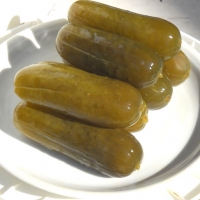Old Fashioned Fermented Garlic Dill Pickles
From tuilelaith 6 years agoIngredients
- whole cinnamon sticks shopping list
- mustard seeds - any color shopping list
- coriander seeds - increasingly being denominated: cilantro seeds shopping list
- allspice - whole shopping list
- black pepper - whole shopping list
- dill seeds - whole - optional, I use more fresh dill - sometimes called dill weed - at today's prices it's not priced like a weed shopping list
- fennel seeds - whole shopping list
- cloves - whole shopping list
- mace - blades (same as whole) shopping list
- celery seeds shopping list
- bay leaves shopping list
- hot chile pepper whole shopping list
- horseradish - the secret ingredient shopping list
- garlic - fresh shopping list
- dill - in bunches shopping list
How to make it
- Old Fashioned Fermented Garlic Dill Pickles use no vinegar. The fermentation produces lactic acid, naturally. This process for pickle making requires maintaining the pickle barrel, crock, plastic bucket or food grade container of your choice at approximately 85° Fahrenheit for 6 weeks. I do this by putting the container in the oven and leaving the oven light on.
- One of the most unusual aspects of this recipe is the ability to add more spices after the initial fermentation. My latest batch, originally had 2 heads of garlic. After 2 weeks in process, a sample taste lacked sufficient garlic and dill flavor. More was added and a week later another sample taste showed those flavors sufficient.
- Most of the recipes for garlic dill pickles on the 'net use vinegar. While vinegar won't make bad pickles, in does change the flavor. I like my old fashioned fermented best so, I'm giving you my way.
- If after the 6 weeks of aging (like fine wine, only much faster) you want to keep your pickles, strain the brine of all solids. Boil it up, allow it to cool to room temperature. Fill you pickle jars with pickles and top over with brine. Heat can those as for any pickle. Genuine dills do not keep well. That isn't to say the go bad. What does happen is they lose their flavor first, and then some texture (goes soft). I never can keep them once made, so for me, that has never been a problem.
- I don't profess to have my spice profile perfected. It's still a work in progress because I only buy cucumbers when the price goes to 3 pound for $1.00 (US Dollar). I give you the spices and herbs I use in this recipe.
- One last point: for every gallon of water use no more than 4 ounces of salt. I weigh this amount on a scale. Please don't try measuring by volume, using, for example: Morton's Kosher Salt and expect to get 4 ounces of salt. Not happening! For those interested this is about a 20° strength brine. I see a lot of dill pickle recipes that call for either fresh or dried ginger. It's not a flavor I like in dill, so I use horseradish. I believe that as the Germans, English and Scandinavians developed their pickle recipes over the years that horseradish would have been a readily available ingredient compared with fresh ginger. Anyway, I use horseradish, cutting the bulb on a mandolin to make thin rounds.
- 6-July-2014 - a small addition. If you are selecting cucumbers, or harvesting them from a garden or farm, leave the stem about ⅛" to ¼" long. Once pickled, those long-ish stems may be removed. For 4 gallons of water, 16 oz. of mixed, dried pickling spice is sufficient. This does not include the weight of the fresh dill. The dill (which I cannot buy at markets in Southern California), should have the seed heads in bloom, but the seeds not yet dropping. That is the best dill. I've added the source of this information as the last URL in the list below. I think that the given quantity of 1 oz. of pickling spice per gallon of water is too little. I use about 4 ozs. of spice per gallon of water. I like a highly flavored pickle. YMMV.
People Who Like This Dish 2
- kaijavb MD
- clbacon Birmingham, AL
- tuilelaith Columbia, MO
- Show up here?Review or Bookmark it! ✔
The Groups
- Not added to any groups yet!


Reviews & Comments 0
-
All Comments
-
Your Comments